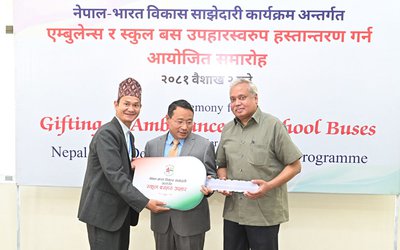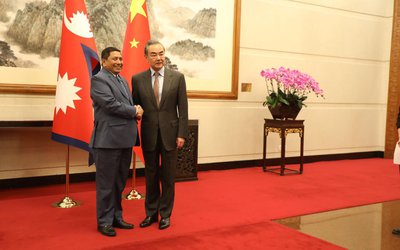Whether it is the first reservoir hydropower project or the Banepa-Bardiabas road, that is, a world class road link between Kathmandu and the Terai plains, Nepal's best infrastructure models have been made possible by the Japanese support.
Sharing a number of new technologies in Nepal over the last sixty years, Japan has recently agreed to support the construction of the first commercial tunnel road in the Naubise-Thankot section of the Tribhuwan highway to end the traffic congestion.
Although Nepal started the tunnel road nearly a century ago, opening the tunnel road in Churia section of Hetauda, Nepal’s planners chose the surface model to construct the roads.
The last earthquakes destroyed many sections of the surface road and other infrastructure, but almost 400 kilometers of small and big tunnels, built for hydro projects, remained intact, indicating that tunnel roads not only shorten the distance but may withstand earthquakes and showing the tunnel technology could be an option for the future.
In this context, Japan’s support in the tunnel road can be a game changer in the road network expansion in Nepal. As Nepal is now in the process to build the Kathmandu Terai Fast Track, the experience of Naubise-Thankot tunnel may change the present perception of Fast Track, which is mostly a surface structure.
With many sharp curves and steep gradients, with poor road conditions and slow vehicular movement, the cost of the products coming to and going out of the capital has gone up.
"Considering the complex geological condition of this stretch, it has long awaited either upgrading or re-aligning with a better alternative,” noted Japanese ambassador to Nepal Masashi Ogawa, referring to the present condition of this road link at the signing program.
With the request of the Nepal government, the Government of Japan has decided to implement this project to improve transport infrastructure of Nepal. This project has been long awaited in the transport sector to achieve a higher level of safety and smooth operation for in and out bound vehicles from the Kathmandu Valley.
After the completion of the construction, traffic congestion will end, while reducing the travel time for vehicles coming in to and going out of Kathmandu valley. This project will significantly improve vehicular movement while significantly decreasing the travel time and transport expenses for fuel and spare parts.
“The Government of Japan considers that this project will be a symbolic landmark for the socio-economic development of Nepal and for the deepening relationship between our two countries,” said Japanese ambassador Ogawa.
Attending the signing ceremony, two senior ministers, deputy Prime Minister and Minister for Finance Krishna Bahadur Mahara and Minister for Physical Infrastructure and Transport Ramesh Lekhak, highlighted the importance attached by Nepal to this project.
The project components include Civil works (Construction of the Tunnel (2.45km), Construction of the Approach Road (2.6km), Construction of 2 Bridges along Approach Road, Construction of Toll facility, Construction of Control office, Disposal Area Development, Construction of Distribution line (4.1km)) and (2) Consulting service (Detailed Design, Preparation of Bidding Document, Construction Supervision, Capacity Development for Operation and Maintenance, Safeguard).
As per the agreement, the Government of Japan has decided to extend a loan assistance of up to sixteen billion six hundred and thirty-six million Japanese yen (¥16,636,000,000), approximately fifteen billion, two hundred and eighty-eight million Nepalese rupees (NRs.15,288,000,000), to the Government of Nepal to implement the Nagdhunga Tunnel Construction Project in Japan’s Fiscal Year 2016.
“Nobuo KISHI, State Minister for Foreign Affairs, has pledged this project on September 1st 2016, at the ceremony of the 60th Anniversary of Establishment of Diplomatic Relations between Japan and Nepal. As pledged during the period, the project is regarded as the 60th anniversary commemoration project,” said a press release issued by Embassy of Japan.
Under this loan assistance, the project will purchase the products and services necessary to construct 5.05 kilometers of tunnel-road stretches from Baad Bhanjyang, Kathmandu to Sisnekhola, Dhading district. 2.45 kilometers of the stretch will be a two-lane tunnel and 2.20 kilometers (Kathmandu side) and 0.40 kilometers (Dhading Side) will be approach roads.
Elaborating the importance of tunnel-road in Nepal, the Embassy has remarked that, like Nepal, Japan is a mountainous country in which tunnels are indispensable for domestic transportation routes. Many tunnels run throughout Japan, and with many years' experience, Japan has highly developed tunnel construction technology.
This project has been long awaited in the transport sector to achieve a higher level of safety and smooth operation for in and out bound vehicles from the Kathmandu Valley. The Government of Japan considers that this project will be a symbolic landmark for the socio-economic development of Nepal and for the deepening relationship between our two countries.
Given Nepal’s current state, the Japanese ambassador pointed out the necessity of sincere support from the concerned authorities of the Government of Nepal for the successful and hassle-free implementation of this project.
As Nepal and Japan are celebrating 60 years of establishment diplomatic relations, the infrastructure being constructed will certainly be yet another cornerstone in enhancing the friendly relations between the people of the two countries.
- TANAHU HYDROPOWER PROEJCT: A Significant Achievement
- Apr 15, 2024
- AMBASSADOR HANAN GODAR: Sharing Pain With A Nepali Family
- Mar 30, 2024
- VISIT OF KfW AND EIB TO NEPAL : Mission Matters
- Mar 25, 2024
- NEPAL BRITAIN SOCIETY: Pratima Pande's Leadership
- Mar 24, 2024
- NEPAL ARMY DAY: Time To Recall Glory
- Mar 15, 2024
















